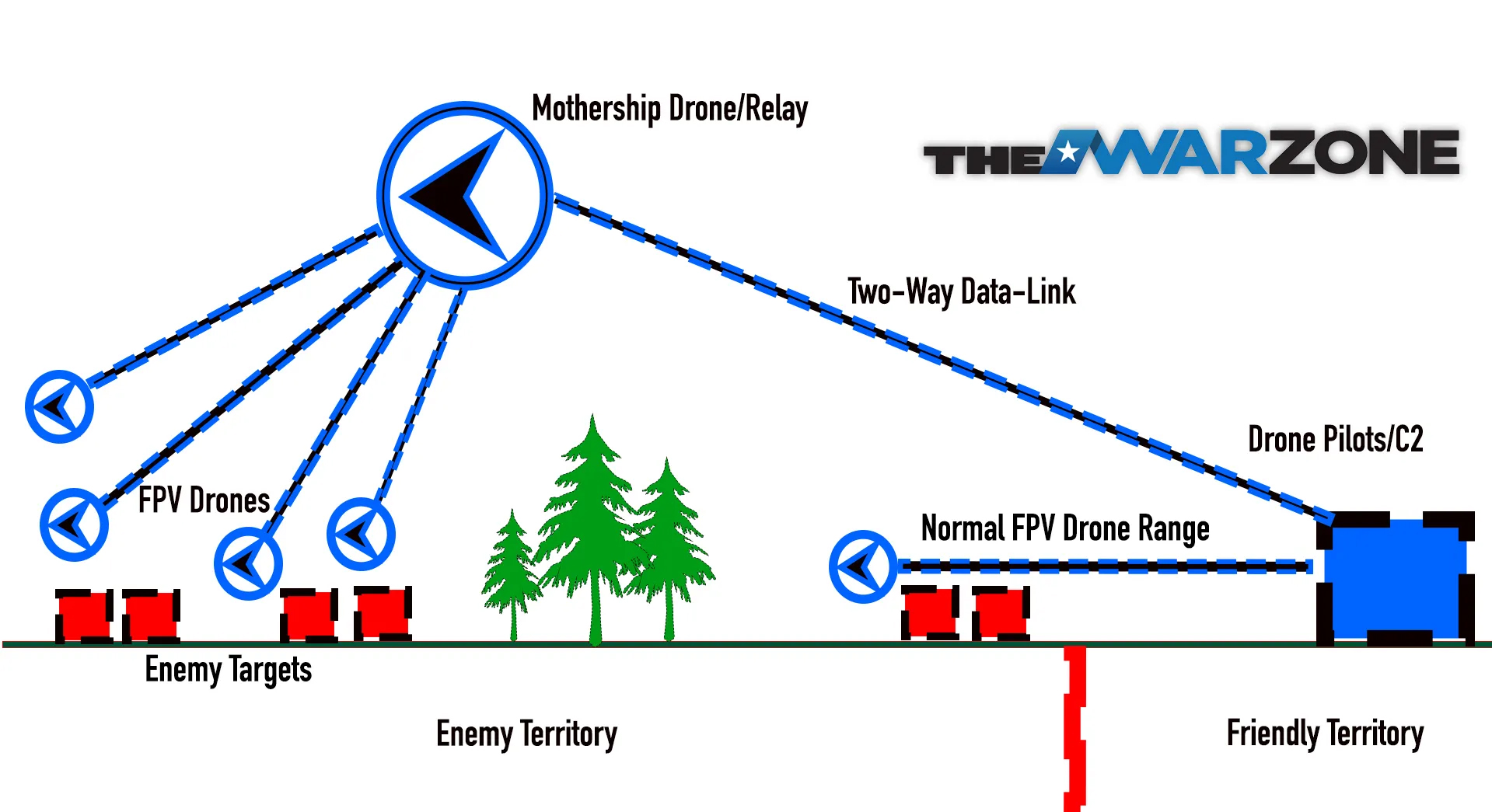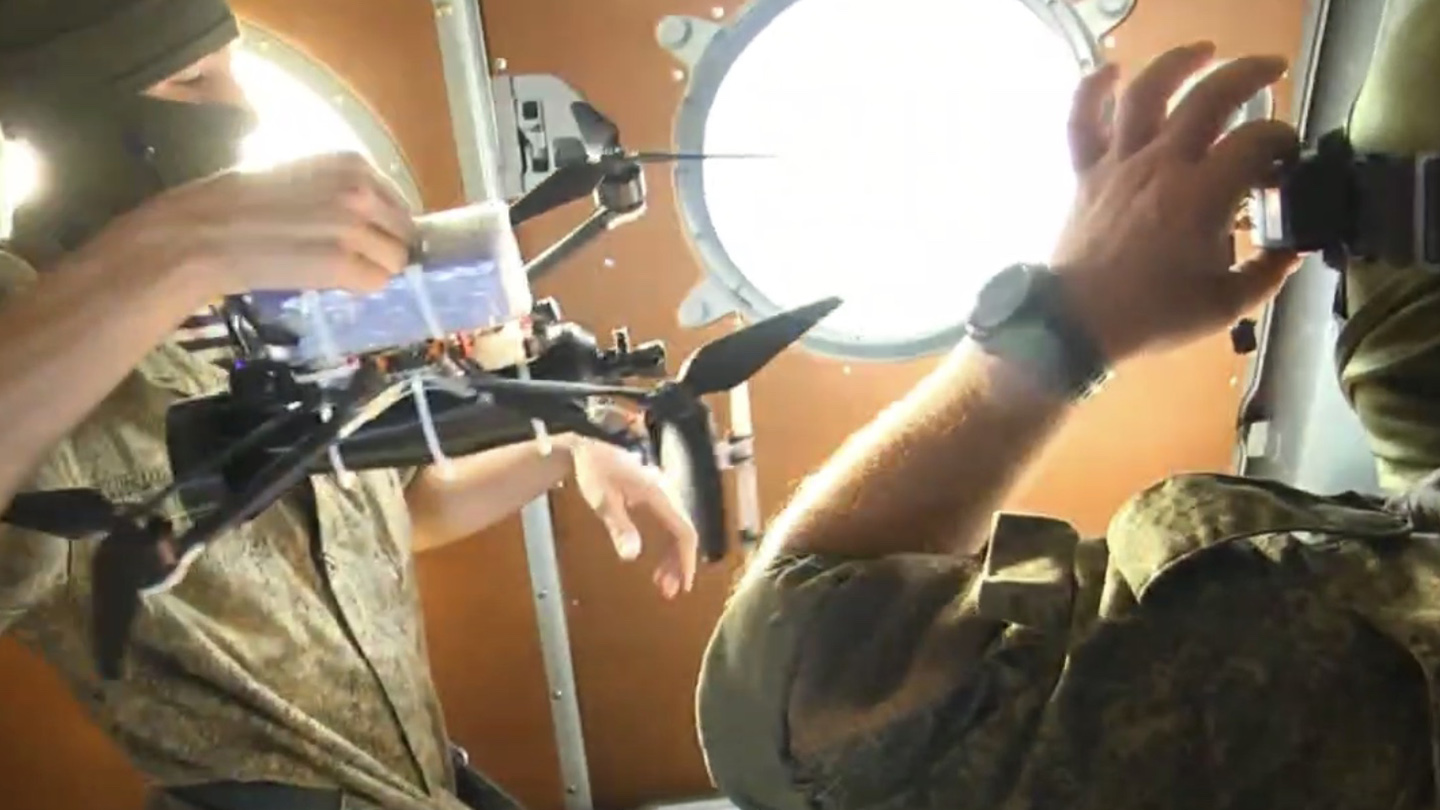Russia is now training its troops to use helicopters to launch first-person view (FPV) drones to counter Ukraine’s uncrewed surface vessels (USVs). New video released by the Russian Tactical_13 Telegram channel is the first time we have seen Russians using a helicopter this way.
The video shows one Russian donning the FPV goggles while another grabs an FPV drone, opens the door, and lets it out over the water. The operator’s view shows the drone flying low over the surface, but no USV in sight.
Using a helicopter as a FPV drone mothership in this way makes a lot of sense. You can greatly expand the reach of FPV drones by delivering them forward via a mothership aircraft. Generally, the FPV drones have a maximum range of about a dozen miles, but operationally usually it’s much less than that. They require continuous line-of-sight communications with their controllers. However, their range can be maximized by avoiding terrain that can interfere with their signal. Elevated antennas and relays installed on balloons or placed on unmanned or manned aircraft, like a helicopter, can extend their connectivity much further with more consistent connectivity. You can read all about this in our previous piece here.

In this case, the helicopter is both the delivery system and the control node. Operating over water and having the controller well above the surface in a helicopter means that the absolute maximum range and flexibility can be squeezed out of these drones. This also fits with a broader move to more advanced ‘air launched effects’ drones that are launched by a mothership aircraft, but this cruder version of the concept makes realizing even a basic capability like this much more attainable.
FPV drones are capable of hunting for USVs, popularly known as drone boats, while also acting as precision-guided munitions nimble enough to chase them down and destroy them, although it’s always harder than it looks.
Using helicopters to launch FPVs is another iteration in the development of drone combat in this war, where FPV drones have dominated the battlefield. Aerial suicide drones have been used to attack boats before, so it makes sense that Russia has moved to the maritime interdiction environment focusing on countering Ukrainian long-range drone boat attacks.
Launching FPV drones from helicopters would allow Russia to cover wide swaths of the Black Sea. Being able to strike Ukrainian sea drones before they can get close to a port or ships is far preferable to relying on close-in weapons from a vessel or shore defenses, booms, and other impediments in a port. The following video shows Ukrainian drone boats being blown up in Sevastopol harbor.
Russia has used FPV drones to attack Ukrainian sea drones before.
What was purported to be the first recorded instance of that emerged in May, which you can read more about here. It was unclear whether video from the time showed an attack on an operational or captured Ukrainian USV. However, the head of Ukraine’s Defense Intelligence Directorate (GUR), Lt. Gen. Kyrylo Budanov, told us at the time that Russia had been using FPV drones to attack Ukrainian drone boats for several months. You can see video of that encounter below. Launching and controlling them via helicopter will allow for responding faster to these threats much farther out then using FPV drones launched from land or vessels.
The use of helicopters to defend against Ukrainian drone boats is a well established tactic. The War Zone first reported in May that the Russian Defense Ministry (MoD) released video it said was an R-73-equipped Ukrainian USV coming under attack from a Russian Navy Ka-29 Helix-B assault helicopter. The USV performed some hard maneuvers to try and escape the Ka-29 but was eventually destroyed, apparently by gunfire. At major suspected target areas, including ports and infrastructure, helicopters are used by the Russians to spot and engage marauding drone boats.
Ukraine’s sea drones have caused widespread havoc on Russia’s Black Sea Fleet, with attacks on ports in Crimea and ships. They have been so devastating that Russia has moved the bulk of its BSF from Crimea to Novorossysk in Russia. Ukrainian Sea Baby drones were used to attack the Kerch Bridge in July 2023.
These attacks have served as a lesson in asymmetrical warfare, where one side with an extremely limited navy can pin down a much larger force with numerous surface and subsurface combatants.
It is natural that Russia would seek to change this equation by doing for the Black Sea what FPV drones have done for ground warfare in Ukraine and Russia. Launching FPVs and controlling them from a helicopter overhead is also likely to quickly migrate far beyond the conflict in Ukraine, with special operations aircrews are already using and perusing similar concepts but with higher-end weapons, many of which offer less flexibility than the FPV drone does, at least over short distances, and cost far more per round. But in the meantime, we will have to watch to see if Russia finds success with this new FPV drone application. Considering how this war has progressed, we will likely find out sooner rather than later.
Contact the author: howard@thewarzone.com
